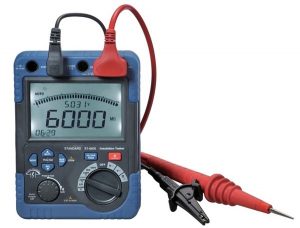Testing Insulation Resistance Uncovers Degradation, Prevents Failures
Whether you’re tracking current leaks or troubleshooting problems in cables and switchgears, insulation resistance testing is crucial to the performance of your power system and equipment, and should be part of every predictive and preventive maintenance program. As insulation ages, it can degrade from electrical, mechanical and thermal stresses and chemical and environmental contaminations, which can lead to insulation failure, and ultimately, damage equipment and systems, cause fires and explosions and injure or kill personnel. By testing insulation resistance routinely, you can pinpoint degradations and prevent breakdowns before they happen.
Conditions that can cause insulation failure may include:
- Excessive temperatures
- Moisture issues
- Corrosive soils and vapors
- Cracks and holes
- Excessive overloads
- Oil and surface contaminations
- Normal succession of operation
An Ounce of Prevention and Prediction
For any maintenance department, monitoring issues in your systems and equipment at an early stage can prevent injury to personnel, lessen downtime and protect the company’s bottom line. A frequent preventative maintenance schedule for testing insulation resistance can help maintenance professionals locate insulation degradation before breakdown happens, protecting machinery from costly major repairs and prolonging its service life. In addition, performing condition-based predictive maintenance monitoring during normal operation can help you track and analyze testing data over time to better set maintenance schedules.
Insulation Resistance Testing Technology
Technology transforms the way maintenance professionals test the integrity of wire insulation. High-voltage digital megohmmeter insulation testers can safely measure resistance to the flow of current in an electrical component or circuit and check the consistency of an electrical circuit to detect issues like degraded insulation and improper circuit connections in equipment, wiring, and power supplies. Resistance is an indicator of the overall condition of the device being tested. Megohmmeters have an internal power supply, such as a battery or a capacitor, which supplies a test voltage to a circuit or component that is turned off. Test leads are connected in a series to the tester and the circuit or device being tested. The meter calculates the difference in voltage between the leads and measures the resistance. Most megohmmeters have two terminals for test lead attachment. The two-terminal, or two-wire, measurement method includes the resistance of the circuit or device being tested and the resistance of the test leads, and generally provides sufficient accuracy for measuring large values of resistance in insulation testing applications. Megohmmeters like the REED R5002 High Voltage Insulation Resistance Tester has four test voltages—500, 1,000, 2,500, and 5,000V—for measuring insulation resistance to 60GΩ and it also measures low-resistance to 6,000Ω and AC and DC voltage to 600V, lighting a warning indicator, sounding a buzzer, and disabling insulation testing when a voltage greater than 30V is detected. A continuity buzzer sounds at less than 50Ω to confirm that the circuit conducts electricity. For a truer indication of insulation condition than a single-point measurement, the meter can automatically calculate PI (polarization index) and DAR (dielectric absorption rate), which are measurements over time. Devices like the REED digital Earth Resistance Clamp uses advanced technology to provide alternative methods for accurate, efficient, ground testing that can save your plant time and money.
Testing Methods
Maintenance programs include insulation resistance testing methods to assess a variety of wires in machinery including switchgears, electrical installation, transformers, motors, generators, lighting circuits, cables, and other insulated equipment, and each application may require its own test procedure to determine if the insulation is functioning or suspect. There are three basic insulation resistance test methods to help manufacturers identify and troubleshoot problems.
Spot Reading or Short-Time
Since most equipment is capacitive, the spot reading method should only be used as a guide to the insulation condition and may require a series of tests over several months for a more accurate assessment. To employ the spot read test, connect the megohmmeter to the insulation you want to test and apply the voltage for approximately 60 seconds. An accurate reading using the spot reading methods requires consistency in duration from test to test, so take into account that temperature and humidity can affect readings. Once you’ve collected the readings from the series of tests, you can record the resistance measurement.
Time-resistance or Absorption
Time-resistance tests measure the absorption result of unaffected insulation compared to moist or contaminated insulation and provide advantages over the spot reading tests because the results aren’t influenced by temperature or equipment size, and don’t require a factoring of previous test results. To conduct a time-resistance test you take consecutive readings at specific time intervals and plot the ratio between readings. Unaffected insulation will take longer to charge, and its values will gradually increase. If the insulation is moist or contains contaminates, the level of resistance is camouflaged by high leakage currents and then over time the values will remain constant.
Step or Multi-voltage
Often, lower stress tests don’t reveal aging or degrading insulation, even though the insulation appears healthy or uncontaminated. Step voltage tests utilize two or more voltages, and compares the results, so you can look for reductions in resistance levels as the voltage level increases, which is typically an indication of weak insulation. You always want to start with the lowest voltage and move to a higher level.
From transformers to cables, degradation in wire insulation will inevitably affect the quality and performance of your equipment. That’s why it is critical to perform insulation resistance tests as part of your regular preventative maintenance program to minimize down time, equipment or parts replacement and injury to personnel.
Pretest Tips:
- De-energize, disconnect the equipment
- Make sure the temperature is appropriate for an accurate reading
- Discharge capacitances
- Check that the applied voltage is not too high
Source: Reed Instruments
